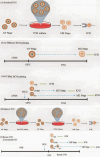Exploring the Potential of In vitro Maturation (IVM) of Oocytes: Indications, Applications, and Treatment Protocols
- PMID: 39132634
- PMCID: PMC11316506
- DOI: 10.18502/ajmb.v16i3.15741
Exploring the Potential of In vitro Maturation (IVM) of Oocytes: Indications, Applications, and Treatment Protocols
Abstract
This review addresses the current understanding of In Vitro Maturation (IVM) treatment, including indications and effective treatment protocols influencing oocyte developmental competence. A comprehensive literature search was performed to gather relevant studies, clinical trials, and reviews related to IVM. Databases such as PubMed, MEDLINE, and pertinent medical journals were searched. The selected literature was analyzed and synthesized to offer a comprehensive overview. IVM has emerged as a promising technique for inducing maturation in immature oocytes across various developmental stages. Its applications extend to areas utilizing In Vitro Fertilization (IVF), gaining traction as a treatment option for Polycystic Ovary Syndrome (PCOS) and fertility preservation in cancer patients. Recent advancements have led to improved global pregnancy rates, resulting in successful births. IVM also holds potential in reducing risks associated with conventional IVF, including ovarian hyperstimulation syndrome and multiple pregnancies. Despite these advantages, IVM adoption in clinical practice remains limited. Ongoing research aims to refine therapeutic protocols and expand clinical indications. IVM holds promise in assisted reproductive technology, spanning applications from cancer patient fertility preservation to addressing PCOS. Enhanced pregnancy rates highlight efficacy, while risk reduction compared to IVF underscores its importance. Further research is needed for optimal use across patient groups, emphasizing protocol refinement and expanded applications.
Keywords: Clinical protocol; Fertility preservation; In vitro maturation oocyte (IVM).
Copyright© 2024 Avicenna Research Institute.
Figures

Similar articles
-
IVF versus ICSI for the fertilization of in-vitro matured human oocytes.Reprod Biomed Online. 2012 Dec;25(6):603-7. doi: 10.1016/j.rbmo.2012.08.001. Epub 2012 Aug 31. Reprod Biomed Online. 2012. PMID: 23063820 Clinical Trial.
-
In vitro maturation (IVM) of human immature oocytes: is it still relevant?Reprod Biol Endocrinol. 2023 Nov 22;21(1):110. doi: 10.1186/s12958-023-01162-x. Reprod Biol Endocrinol. 2023. PMID: 37993914 Free PMC article. Review.
-
In vitro maturation without gonadotropins versus in vitro fertilization with hyperstimulation in women with polycystic ovary syndrome: a non-inferiority randomized controlled trial.Hum Reprod. 2022 Jan 28;37(2):242-253. doi: 10.1093/humrep/deab243. Hum Reprod. 2022. PMID: 34849920 Free PMC article. Clinical Trial.
-
In vitro maturation and its role in clinical assisted reproductive technology.Obstet Gynecol Surv. 2015 Jan;70(1):45-57. doi: 10.1097/OGX.0000000000000150. Obstet Gynecol Surv. 2015. PMID: 25616347 Review.
-
[Comparision of in vitro maturation applied in PCOS and non-PCOS patients undergo stimulated and unstimulated protocols].Zhonghua Fu Chan Ke Za Zhi. 2014 Dec;49(12):903-8. Zhonghua Fu Chan Ke Za Zhi. 2014. PMID: 25608990 Chinese.
Cited by
-
Optimizing in vitro maturation of oocytes with nitric oxide-loaded microbubbles.Front Cell Dev Biol. 2025 May 13;13:1518226. doi: 10.3389/fcell.2025.1518226. eCollection 2025. Front Cell Dev Biol. 2025. PMID: 40433543 Free PMC article.
-
Follicular fluid meiosis activating sterol supplementation enhances oocyte maturation and fertilization in a microfluidic system: A lab trial study.Int J Reprod Biomed. 2024 Dec 2;22(10):781-792. doi: 10.18502/ijrm.v22i10.17663. eCollection 2024 Oct. Int J Reprod Biomed. 2024. PMID: 39906093 Free PMC article.
References
-
- Li H, Chian R-C. Follicular development and oocyte growth. In: Chian RC., Nargund G., Huang J. (eds) Development of In Vitro Maturation for Human Oocytes. Springer, Cham. 2017;37–57.
-
- Steptoe PC, Edwards RG. Birth after the reimplantation of a human embryo. Lancet 1978;312(8085):366. - PubMed
-
- Timmons D, Montrief T, Koyfman A, Long B. Ovarian hyperstimulation syndrome: A review for emergency clinicians. Am J Emerg Med 2019;37(8):1577–84. - PubMed
Publication types
LinkOut - more resources
Full Text Sources
